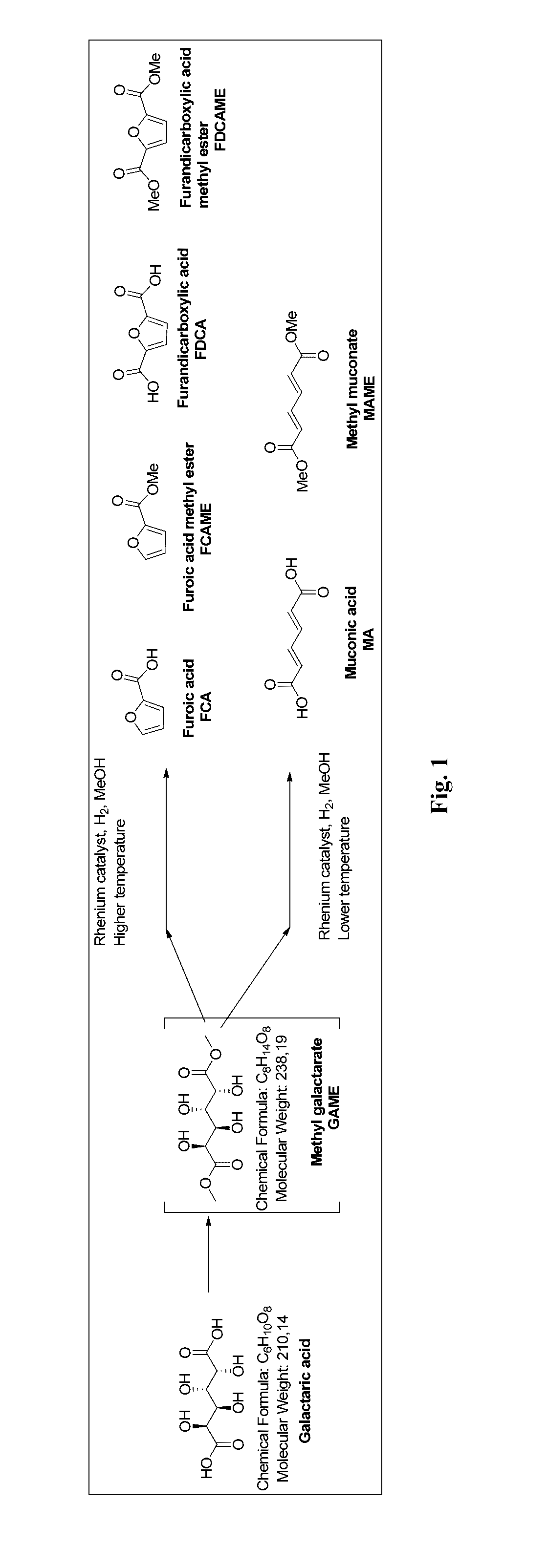Method for producing muconic acids and furans from aldaric acids
a technology of aldaric acid and muconic acid, which is applied in the preparation of carboxylic compounds, metal/metal-oxide/metal-hydroxide catalysts, physical/chemical process catalysts, etc., can solve the problems that bio compounds are typically too oxygen-rich to be compatible with the current petroleum-based industry, and achieve low energy consumption, low waste production, and easy scalability and purification of obtained products
- Summary
- Abstract
- Description
- Claims
- Application Information
AI Technical Summary
Benefits of technology
Problems solved by technology
Method used
Image
Examples
example 1 catalytic
Dehydroxylation of Galactaric Acid (I) for the Production of Compounds II-VII
[0039]Galactaric acid (1.0 g, 4.76 mmol), methyl trioxo rhenium (0.12 g, 0.47 mmol, 10 mol %) and methanol (10 ml) were charged in the reaction vessel. The reaction vessel was pressurised with hydrogen and heated up to the reaction temperature (Table 1). After the indicated reaction time the mixture was cooled down to room temperature, any solid precipitate was filtered, washed with methanol (5 ml) and dried. The solvent fraction was concentrated in a rotary evaporator. Purification was by flash silica column chromatography. The different fractions were analysed with GC-FID, GC-MS and NMR.
TABLE 1Experiments with galactaric acid with MTO / MeOHTGas,timeYield (%)#(° C.)(bar)(h)IIIIIIVVVIVII1100H2 (5)700.110.70.12100 H2 (10)480.026.70.030.170.090.133120H2 (5)4812.30.080.090.124150H2 (5)700.10.43.15.20.21.45200H2 (5)20.80.911.21.91.70.66200H2 (5)10.11.69.614.70.62.37200H2 (5)0.250.871.46.0914.00.883.6
example 2 catalytic
Dehydroxylation of Galactaric Acid (I) for the Production of Compound VIII
[0040]Galactaric acid (1.0 g, 4.76 mmol), methyl trioxo rhenium (0.12 g, 0.47 mmol, 10 mol %) and ethanol (10 ml) were charged in the reaction vessel. The reaction vessel was pressurised with hydrogen and heated up to the reaction temperature (Table 2). After the indicated reaction time the mixture was cooled down to room temperature, any solid precipitate was filtered, washed with ethanol (5 ml) and dried. The solvent fraction was concentrated in a rotary evaporator. The different fractions were analysed with GC-FID, and GC-MS.
TABLE 2Experiments with galactaric acid with MTO / EtOHYieldTGas,time(%)#(° C.)(bar)(h)VIII8120H2 (5)4819.2
example 3 catalytic
Dehydroxylation of Galactaric Acid (I) for the Production of Compound IX
[0041]Galactaric acid (1.0 g, 4.76 mmol), methyl trioxo rhenium (0.12 g, 0.47 mmol, 10 mol %) and 1-butanol (10 ml) were charged in the reaction vessel. The reaction vessel was pressurised with hydrogen and heated up to the reaction temperature (Table 3). After the indicated reaction time the mixture was cooled down to room temperature, any solid precipitate was filtered, washed with butanol (5 ml) and dried. The solvent fraction was concentrated in a rotary evaporator. The different fractions were analysed with GC-FID, and GC-MS.
TABLE 3Experiments with galactaric acid with MTO / BuOHYieldTGas,time(%)#(° C.)(bar)(h)IX9120H2 (5)4821.4
PUM
| Property | Measurement | Unit |
|---|---|---|
| Temperature | aaaaa | aaaaa |
| Temperature | aaaaa | aaaaa |
| Temperature | aaaaa | aaaaa |
Abstract
Description
Claims
Application Information
 Login to View More
Login to View More - R&D
- Intellectual Property
- Life Sciences
- Materials
- Tech Scout
- Unparalleled Data Quality
- Higher Quality Content
- 60% Fewer Hallucinations
Browse by: Latest US Patents, China's latest patents, Technical Efficacy Thesaurus, Application Domain, Technology Topic, Popular Technical Reports.
© 2025 PatSnap. All rights reserved.Legal|Privacy policy|Modern Slavery Act Transparency Statement|Sitemap|About US| Contact US: help@patsnap.com



